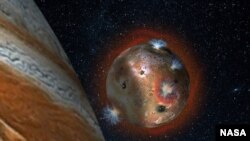The thin atmosphere on Jupiter’s volcanic moon, Io, “collapses” when the moon enters the gas giant’s shadow, according to a new study.
Writing in the Journal of Geophysical Research, scientists from the Southwest Research Institute in Boulder, Colorado, say the thin atmosphere freezes when the sun's light is blocked.
Io is the solar system’s most volcanic body. The volcanoes are caused by the constant push and pull of Jupiter’s gravity, and when they erupt, they spew large amounts of sulfur dioxide gas that can rise nearly 500 kilometers above the moon’s surface.
“This confirms that Io’s atmosphere is in a constant state of collapse and repair, and shows that a large fraction of the atmosphere is supported by sublimation of SO2 ice,” said John Spencer, a co-author of the new study. “Though Io’s hyperactive volcanoes are the ultimate source of the SO2, sunlight controls the atmospheric pressure on a daily basis by controlling the temperature of the ice on the surface. We’ve long suspected this, but can finally watch it happen.”
When in Jupiter’s shadow, the moon's temperature drops considerably, and the sulfur dioxide gas in Io’s atmosphere freezes and then collapses to the surface. When heated again, it converts back to a gas. Io is in the dark for about 2 hours of every Io day, which is about 1.7 Earth days.
The conclusion about how Io’s atmosphere behaves is based on observations of the moon using the large eight-meter Gemini North telescope in Hawaii and an instrument called the Texas Echelon Cross Echelle Spectrograph (TEXES). Previously, such observations were not possible because of the darkness in Jupiter’s shadow. Using the TEXES instrument, however, researchers were able to measure heat radiation from the moon.
Researchers made their observations of Io over two nights in November of 2013 when the moon was nearly 700 million kilometers from Earth.









